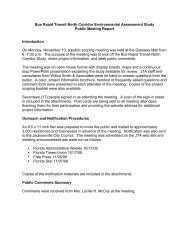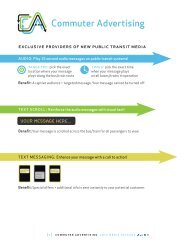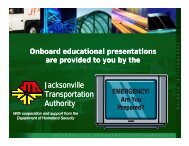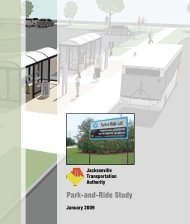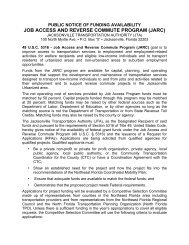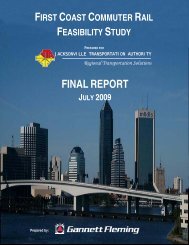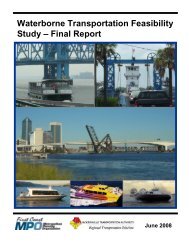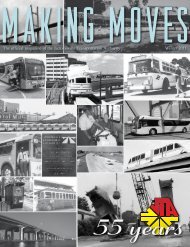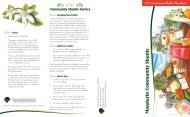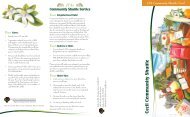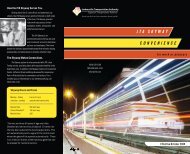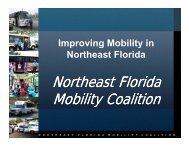Policy Framework - Jacksonville Transportation Authority
Policy Framework - Jacksonville Transportation Authority
Policy Framework - Jacksonville Transportation Authority
Create successful ePaper yourself
Turn your PDF publications into a flip-book with our unique Google optimized e-Paper software.
City of <strong>Jacksonville</strong><br />
<strong>Policy</strong> <strong>Framework</strong> for Transit-Oriented Development<br />
Transit Technologies<br />
When planning a TOD project or district, it is important to consider the kind of transit technology that will<br />
serve the area. The major transit technologies are commuter rail, express bus, light rail, bus rapid transit,<br />
monorail, streetcar, and local service bus. Each technology has characteristics that influence the intensity,<br />
spacing, and form of TODs. Transit technology choices will largely reflect the needs of the transit system, but<br />
they will also consider future development and redevelopment plans along a prospective alignment. While<br />
TODs respond to transit technologies, they also can influence what technologies are viable and best suited for<br />
a particular corridor. The major transit technologies are described briefly below. Each technology has distinct<br />
vehicle and operational characteristics. Vehicle type, size, costs, and right-of-way requirements vary among<br />
the different technologies. These factors influence operational characteristics like optimal travel distances and<br />
times, station spacing, and the size and nature of station service areas.<br />
Commuter Rail<br />
Commuter rail technology utilizes relatively large<br />
train cars that can carry a high number of passengers.<br />
Commuter rail operates in its own right-of-way,<br />
separate from automobile traffic; but in many cities,<br />
commuter trains share track and right-of-way with<br />
freight rail carriers. Because of the capacities and<br />
speeds achievable with commuter rail, this technology<br />
is best suited for covering long distances with stations<br />
spaced from 1 to 5 miles apart. Station service areas<br />
are large and often accessed by driving from the<br />
surrounding community.<br />
Commuter rail is most effective in areas that have<br />
strong regional centers with high employment<br />
densities, linking them to suburban communities.<br />
However, suburban commuter rail station areas can<br />
include an even mix of residential and commercial<br />
uses at medium to high densities. Park and ride access<br />
is appropriate near commuter station areas given that<br />
they will draw ridership from nearby communities.<br />
Walkable TOD communities should be implemented<br />
in the immediate vicinity of the station, transitioning<br />
smoothly to a lower density development pattern in<br />
the greater station area.<br />
Service Area:1mile to 5 miles<br />
Station Spacing: 1miles to 5 miles<br />
Optimal Transit Shed: 5 miles to 100 miles<br />
Commuter Rail Characteristics<br />
Express Bus<br />
An express bus operates in a similar manner to<br />
commuter rail, serving a regional center from<br />
outlying areas, with few stops in between. However,<br />
express bus cannot provide the same passenger<br />
capacity and speed as commuter rail. It is well suited<br />
for serving low to medium density communities and<br />
often only operates during the morning and evening<br />
peak commuting hours to allow suburban residents<br />
18 | Transit Technologies




